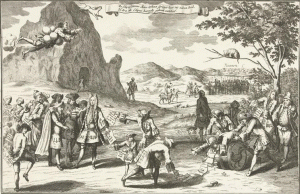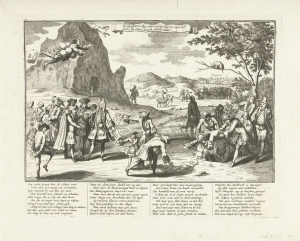Anonymous, ‘De schynschoone actie-sphinx springt hier zig zelven dood, zo dra als Edipus het vals geheim ontbloot.’ Het Groote Tafereel der Dwaasheid (serietitel) 1720, copper etching on paper, 32,2 x 38,3 cm.
This engraving is a cartoon on speculation, personified by the floating man with balloons (air filled pig bladders), illustrating the Dutch term ‘windhandel’ literally: ‘trade in wind’. His upward movement is contradicted by a sphinx that just threw her heavy body from a high rock: her traditional wings indeed are missing here. The banderole identifies her quite remarkably as ‘De SchijnSchone Actie-Sphinx’, that reads something like ‘The Fake Beauty Action-Sphinx’ . She jumps towards her death, as the text continues to explain, after Oedipus uncovers her spurious secret. So she, too, is the embodiment of, unmasked by the wise Oedipus. All the figures are grouped around the Scotsh economist John Law (1671-1729), wearing the wig, who became extraordinairy rich in the trade of shares which worth was actually based on nothing. Dutch traders followed this example, but the trade led to a serious crash on the financial market in 1720.
The engraving once was was one of the warnings, part of the satirical book on stockjobbing, ‘Het Groote Tafereel der Dwaasheid’ (The Great Mirror of Folly). The book itself is called ‘Bibliographical horror’* bij the curator of Library of the Erasmus University in Rotterdam: although the different specimen in their collection bear the same name, the content of books differs as each copy holds arbitrairy engravings and texts related to the topic: apparently also book sellers tried to benefit from the situation by rearranging
Here the engraving is accompanied by a (Dutch) poem as well:
Een zieke speugt hier de Acties weêr,
Waar meê zyn maag was overláden,
Vast rollende op een Ton, ter neêr,
Dus lérende met schand en schaden;
Men raapt die yv’rig uit den drek,
Om die tot winst weêr kwyt te ráken,
Terwyl een wind’rige Actie-gek,
Scheynt met een Schagg’raar koop te máken,
Om dus zyn geld voor wind en waan,
Eer lang te zien in rook vergaan,
Want de Actie-prys daald uur op uur,
Waar door de Dienstmaagd heel verlégen,
Die klad-papieren smyt in ‘t vuur,
Waar meê dat de aâr zyn aars gaat vegen,
Gints vliegt een Snoeshaan door de lugt,
Op Varkens blázen voort gedréven,
Dog heel gelukkig, zo die vlugt,
Niet word beslóten met zyn léven,
Terwyl die by den blanken stroom,
Kykt ‘t Actie-katjen uit den boom,
Daar zyn konfrater meê nieuws gierig,
In ‘t water bruit, en haast verzinckt,
Nog handeld men al even vierig,
Schoon hy in d’Actie-streem verdrinkt,
Daar weêr eene and’re heel onzinnig,
Wil met zyn stok dwars in het hol,
Gints ryd’er een heel snel en vinnig,
Die ‘t meê niet min schort in de bol,
Regt naar Vianen en zyn vrinden,
Maar ach! daar is geen plaats te vinden,
Waarom! die Stadt ook is omringt,
Op alle wegen met Zoldáten;
Wyl ‘t Monster zig te barsten springt,
En moet het heilloos leven láten,
Als Edipus ‘t geheim ontdekt,
Van zyn verborge raadzel vrágen,
‘t Geen tot een Zinnebeeld verstrekt,
Van de opgeworpe Bubbel-vlágen,
Dies kan men hun geheim verstaan,
Wel meê haast uit zig zelf vergaan.
Arpots, Robert, ‘Het groote tafereel der dwaasheid: de aandelenbubbel van 1720’ on: http://www.ru.nl/ubn/vm_zandbak/test-gemma/vm/uitgelicht/1506-groote-tafereel-dwaasheid-aandelenbubbel-1720/
Goetzmann, William N., Catherine Labio, K. Geert Rouwenhorst, & Timothy G. Young (eds.), The Great Mirror of Folly. Finance, Culture, and the Crash of 1720. New Haven: Yale University Press, 2013.

